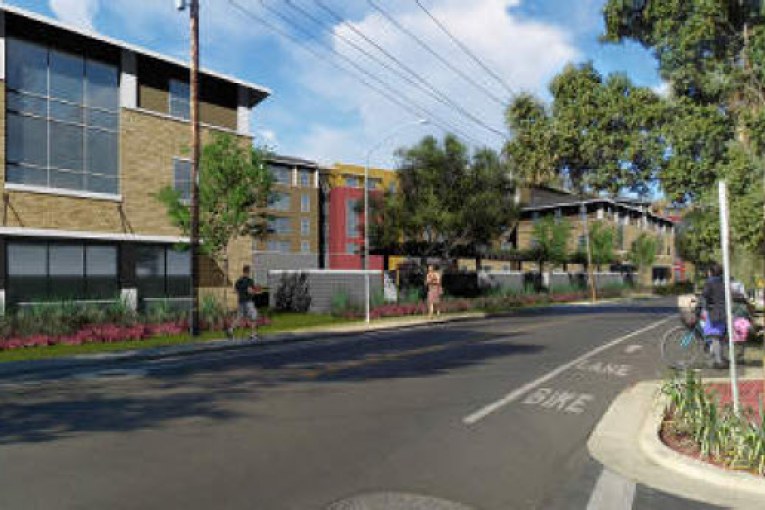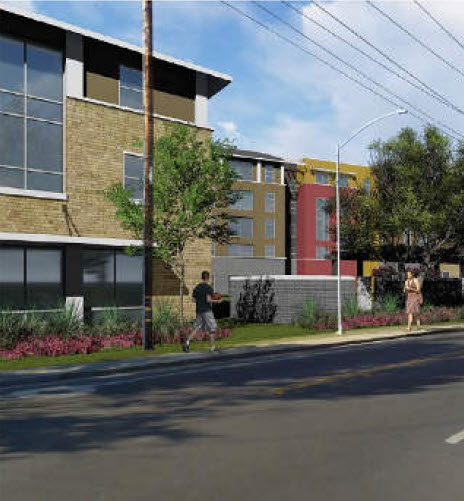

The Planning Commission staff report for Lincoln40 provides for some interesting discussion. Staff gets its opportunity to respond to some of the community dialogue and discussion, and here we highlight some of their points.
The General Plan Urban Design (UD) Standard 2.4d states that multifamily projects should not exceed 150 units. But, like the design guidelines discussion from Trackside, “[t]his policy provides guidance for general intent and is not an absolute standard.”
Staff notes a number of comments made during public meetings and in writing about the density of the proposed project, including the use of the term “mega-dorm,” which staff points out is “not defined by any City document.”
Staff notes, “The comment about the project’s density is not consistent with the applicable General Plan policies. The proposal does not exceed 150 units. It is a 130-unit project.”
Staff believes that “the intent of this policy is to avoid excessively large-scale apartment complexes of buildings and surface parking that can be found in other cities and to promote architectural diversity.”
They point out that most multifamily sites appear to be under or within that 150 unit range. However there are exceptions, including: Sterling Apartments, Anderson Place Apartments (240 units), University Retirement Community (238), Cranbrook Apartments (216), Tanglewood Apartments (216) and Parkside Apartments (200).
“Conformity with every General Plan policy is not a requirement as statements of policy and direction, rather than strict standards,” staff continues.
They also note the lack of restrictions “preventing an apartment complex from leasing by the bedroom,” pointing out that this occurs at sites like the U Apartments and Adobe Apartments for starters.
Additionally, they write that “no existing apartment complex currently has restrictions against doubling up in rooms,” ironically with the exception of Sterling Apartments.
The city’s General Plan defines infill as “urban development or redevelopment on vacant or ‘underutilized’ urban-designated land within a city’s boundaries, as an alternative to accommodating  growth through expansions of city boundaries.”
growth through expansions of city boundaries.”
The General Plan also defines underutilized designated land as “developed or partially developed urban-designated land which could be developed in other uses or more dense and intense use consistent with City policies, surrounding uses and potential impact issues.”
Staff writes: “The City’s vision for infill development is to encourage and maximize opportunities for infill development projects that are beneficial to the community, protective of existing neighborhoods, and well designed. The benefits of infill include resource conservation, efficiency of facilities and services, promotion of alternative modes of transportation, and opportunities for diverse housing and mixed use options.”
They argue that there is a critical need for rental housing, which they say “is evidenced by apartment vacancy rates in the City that have been near or below 1% in recent years (0.2% in 2016), according to the apartment vacancy surveys conducted annually by U.C. Davis.”
Importantly, “This vacancy rate has effects on the City’s single-family residential neighborhoods, which can be impacted by rental properties.”
Staff believes that the demand for university student housing is impacting all housing types in the city as a whole.
They write, “To the extent that the demand for student rentals may have a negative effect on all housing types and residential neighborhoods not originally intended for that use, the development of student-oriented housing is necessary.”
Without student-oriented housing, “students are more likely to be dispersed throughout the City. This may reduce the intensity of related problems, but spreads the problems over a larger area of the City, especially in single-family residential neighborhoods.”
While some argue that the concentration of student housing results “in the myriad of parking and noise concerns to surrounding neighborhoods, there is the other side of the discussion regarding the benefits of the concentration.”
Staff believes that “the benefits outweigh the concerns expressed.”
They cite advantages of Lincoln40’s location, site plan, and management plan which they believe “are intended to address the potential concerns associated with concentration of student housing.
“The subject site is within walking distance from UC Davis, bike access, and bus line. The benefits of this site as (described) include multimodal transportation, including relatively easy travel to UCD campus unlike dispersed student housing in single-family residential neighborhoods.”
With the city’s low vacancy rate, “it is evident that the market is able to absorb student-oriented apartments. It is foreseeable that all units can be occupied.”
Staff believes, as we do: “It may contribute to a shift of students out of single-family homes or out of ‘traditional’ apartments, thereby freeing up those units for families and the general workforce. Thus, it contributes to the mix of housing types in the City.
“The nature of the project design allows for easy conversion to other residential uses, such as single-occupancy residence (SROs, single-room occupancies) or co-housing,” staff adds.
Staff also addresses the issue of student housing growth.
They note: “The U.C. Davis student population has always had a strong influence on City housing and can be a source of contention between the University and the City with impacts in the City’s residential neighborhoods as a particular issue.
“Plans for student growth can further strain the relationship,” they write. “While the University has plans to increase its housing to accommodate growth, there is currently a shortage of housing to meet the current needs of the City and University.
“There is a concern that the University may not be doing enough to provide its fair share of student housing on campus. This issue has been strongly presented by some interested citizens in relation to this proposal at various public meetings thus far held on Lincoln40.”
This is the point we have been making. We agree that the university needs to provide more housing on campus. The Vanguard as well as the city council has pushed for the 100/50 plan with half of the overall students housed on campus. But the quickest way to add housing is to build housing in the city.
Lincoln40 and projects like it can provide immediate relief to the 0.2 percent vacancy rate and can do it within the scope of existing land use policies – keeping the apartment complex size under 150 units and focusing on infill.
Nishi could be an exception, of course, to both of these, but we are not there yet. Right now the focus is on Lincoln40 and the need for student housing that it meets.
—David M. Greenwald reporting


“Lincoln40 and projects like it can provide immediate relief to the 0.2 percent vacancy rate and can do it within the scope of existing land use policies – keeping the apartment complex size under 150 units and focusing on infill.”
This would certainly be a true statement if there were little to no growth anticipated for the city. Since this is not the case, I find this to be far too optimistic a statement and borders on the “grow our way out of trouble” philosophy that has, to date, proven to be unsuccessful. This despite projects such as The Cannery, which in part was supposed to help alleviate the 0.2 % vacancy rate. ( And yes, I know it is not completely built out. But it has not budged the needle to date, and I predict it will not).
I don’t think any of the apartments planned for The Cannery are yet occupied, though the lottery for the 60+ units has been held. I don’t recall anyone advocating for The Cannery on the basis of making a significant effect on the apartment vacancy rate, as it’s a relatively small number of units.
By the way, here are the hurdles applicants had to clear to live there. Not exactly promising for any young adults without credit history. https://docs.wixstatic.com/ugd/254c4c_70be46929e85467f8765bf7f4144b449.pdf
I’m guess I’m not following your point Tia. What does Cannery have to do with infill projects like Lincoln40?
I’m a student and just discovered the Vanguard and talk of additional housing for students in Davis. One thing that seems to be missing in all of these articles is an estimate on how much rent will be in these apartments, especially ones like Lincoln40 that are rented by the bed. Price is the #1 factor for me and many of my friends and I cannot imagine paying individually for a 1 bed+bath for myself will be cheaper than six of us living in a four bed/two bath single-family home.
From what I can see, students will continue to go for single family homes because it will be the second best option next to apartments rented out by the unit and the students that get left out will have to take out even more loans to pay for these expensive apartments.